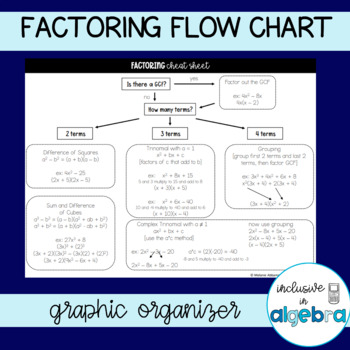Inclusive in Algebra
124 Followers
Grade Levels
9th - 11th
Subjects
Resource Type
Standards
CCSSHSA-SSE.A.2
Formats Included
- PDF
Pages
1 page
Inclusive in Algebra
124 Followers
Also included in
- There is no “best way” to teach factoring, but what is true is that students benefit from practice to become factoring experts! This no prep factoring polynomials resource has guided practice for several types of factoring, including: Greatest Common Factor (GCF)Difference of SquaresPerfect Square TPrice $3.80Original Price $4.75Save $0.95
Description
Graphic organizers help students stay organized and retain information!
This graphic organizer helps students use an appropriate factoring technique for factoring quadratic or polynomial expressions.
The flow chart guides students through different factoring techniques based on the number of terms of the expression.
My students really benefit from flow charts and graphic organizers to help present material and information in a visual and meaningful way.
⭐ Factoring methods included:
GCF
Difference of Squares
Sum and Difference of Cubes
Trinomial with a = 1
Trinomial with a not = 1
Grouping
⭐ This resource includes:
- A one-page graphic organizer/flow chart for different factoring techniques. There is an example included for each technique.
⭐ Looking for more factoring resources? Similar products include:
Total Pages
1 page
Answer Key
N/A
Teaching Duration
30 minutes
Last updated Jul 1st, 2021
Report this resource to TPT
Reported resources will be reviewed by our team. Report this resource to let us know if this resource violates TPT’s content guidelines.
Standards
to see state-specific standards (only available in the US).
CCSSHSA-SSE.A.2
Use the structure of an expression to identify ways to rewrite it. For example, see 𝘹⁴ – 𝘺⁴ as (𝘹²)² – (𝘺²)², thus recognizing it as a difference of squares that can be factored as (𝘹² – 𝘺²)(𝘹² + 𝘺²).




